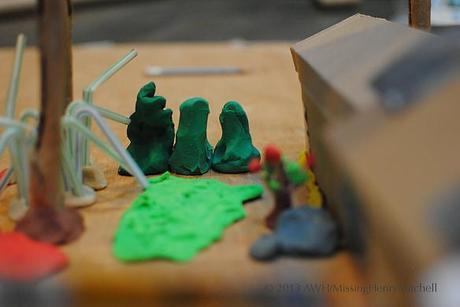The house addition inches onward. Now that the sheathing is on and the windows are installed, I am able to grasp how this developing garden room may relate to the house. I can clearly watch patterns of light and shade, and notice where water collects and what stays dry (of course, that will change a bit when the gutters are installed).

The new addition with windows and wall and roof sheathing installed.
As much as I love to rearrange my plant furniture, I recognize that if I am to embrace my goal of producing more of my family’s food, and particularly fruit, I had better devise a plan and stick with it. Fruiting trees and shrubs do not appreciate being moved, nor do I appreciate a lack of production from them.
For once in a rare time, the plants and I are in agreement.
I like to sketch a bit, but I’m not terribly talented at it. I do love a good mockup, though. In the past this has tended towards my scrounging bits of junk, like fallen tree limbs, lumber scraps, and overturned buckets, and placing such objects around the garden to simulate borders, edges, and large shrubs and perennials. Then I live with it for a while. But it is an uneasy existence, as I have to explain to visitors and neighbors that really, I don’t mean to live in an untidy dump. There’s a purpose to it. I’m visioning.
There is, however, a better way.
Making a Garden Mockup
Exploring the attic recently, I found a long, narrow piece of plywood. Dragging it down the rickety attic stairs (not advisable), I dug out a copy of our plat map, a calculator, and a tape measure.
A quick cut or two with the circular saw and I have a board whose proportions mimic our lot by a ratio of 1″: 3.75′. Time for nerdy arts and crafts!

I raided the recycling bin and the kids’ craft supplies, commandeering some cardboard boxes, a bag of drinking straws, duct tape, toothpicks, paper bowls, paper towel rolls, and modeling clay.
First I assembled the house, measuring to scale, cutting out the cardboard, and duct-taping it together. The real roof has a relatively shallow slope, and the corresponding cardboard roof doesn’t sit well on the walls of the house, but as the cardboard house doesn’t have to pass any safety inspections, we shall give it some grace.
Paper towel rolls (cut and slimmed down to approximate diameter scale) topped with upturned paper bowls represent, if you will, very tall oak trees. The bowls, when they stay on their trunks, provide reasonable representations of the shade cast by the trees.

Time to play with the clay. The red snake at right represents a low brick wall, roughly 12 inches high. The bizarre drinking straw forms are Lonicera fragrantissima, or winter honeysuckle, which is an ungainly but gorgeously smelling evergreen shrub whose long, thin branches sprout from the base like a forsythia’s. Pipe cleaners would be a more appropriate craft material here, but alas, we are all out.
The three dark green pyramidal lumps in the foreground are proposed Amelanchier alnifolia ‘Northline,’ one of the fruits recommended by Lee Reich in his book Uncommon Fruits for Every Garden. It’s probably a little hopeful to model them in dense pyramidal shapes; open blobs might be more accurate.
On the left (above), near the house, is Viburnum x burkwoodii ’Mohawk,’ which already lives on the property but needs transplanting. I put some gray rocks nearby, which would need to go in before any planting gets done. And the green smudge in the middle is my proposed Carex lawn.

The proposed view from the kitchen window.
This design is the rough outline of one option, playing with my idea of a cloister garden. The space would also be filled with a mixture of vegetables and perennial and annual ornamentals, but modeling that level of detail requires both more clay and more leisure time than I have.
I welcome your ideas and comments.

